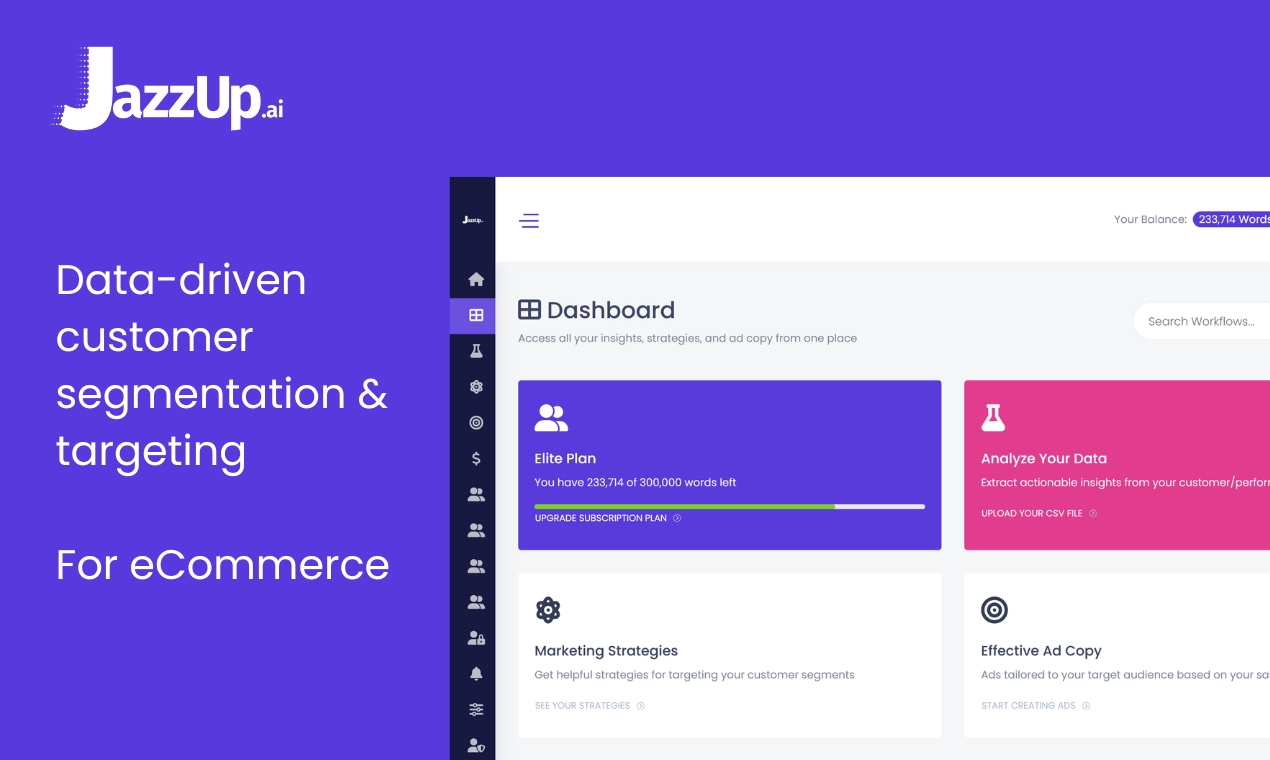
Why E-Commerce Businesses Should Enjoy Customer Segmentation Benefits
E-Commerce offers a wealth of opportunities for small businesses. However, this exciting landscape also presents a set of unique challenges. Here’s a closer look at some of the hurdles small e-commerce businesses often face:
- Standing Out in a Saturated Market: The online marketplace is teeming with competition. From established giants to nimble startups, small businesses need help to differentiate themselves and capture customer attention.
- Generic Marketing with Limited Impact: Generic marketing campaigns with a “spray and pray” approach often yield minimal results. Reaching the right audience with the right message is crucial for driving conversions and sales.
- Limited Resources and Budgets: Small businesses typically have constraints on personnel, time, and marketing budgets. Optimizing resources and maximizing the return on investment (ROI) for marketing efforts is essential.
- Understanding Customer Needs: With a physical storefront, gaining a deep understanding of customer needs and preferences can be easier. Personalization is critical in today’s e-commerce landscape, yet obtaining customer insights can be challenging.
Customer Segmentation in Numbers
Wondering why small e-commerce businesses need customer segmentation? These figures can provide more context:
- Personalized marketing emails can boost conversion rates by up to 760% (Statista, 2023).
- Marketers report that segmented emails drive 30% more opens and 50% more clickthroughs than unsegmented ones (HubSpot State of Marketing Report, 2023).
Customer Segmentation for Small Business: The Key to Unlocking Growth
Customer segmentation steps in as a powerful solution for small e-commerce businesses. By segmenting your customer base, you can overcome these challenges and unlock significant growth:
- Targeted Marketing for Maximum Impact: Segmentation allows you to tailor your marketing messages and product recommendations to resonate with specific customer segments. This laser-focused approach cuts through the noise, grabs attention, and drives conversions.
- Personalized Customer Experiences: By understanding the characteristics and preferences of each customer segment, you can personalize the shopping experience. This fosters customer loyalty and encourages repeat business.
- Data-Driven Decision Making: Segmentation empowers you to leverage valuable customer data to make informed decisions. You can identify customer trends, optimize product offerings, and allocate marketing resources more effectively.
- Resource Optimization: Focusing your marketing efforts on specific customer segments can maximize the impact of your limited resources and budget.
Customer segmentation empowers small e-commerce businesses to move beyond a one-size-fits-all approach. It allows you to cater to your customers’ unique needs, personalize their journeys, and ultimately achieve sustainable business growth in a competitive online marketplace. Enjoy customer segmentation benefits that result in growth for your business.
Benefits of E-Commerce Customer Segmentation
1. Increased Sales and Conversion Rates
Imagine trying to sell winter jackets in Miami. It wouldn’t be very effective. Customer segmentation allows you to target your marketing efforts to the right audience at the right time. By understanding your customer base and segmenting them based on relevant criteria, you can create targeted marketing campaigns with messaging and product recommendations that resonate with their specific needs and preferences. This laser-focused approach leads to higher conversion rates and increased sales.
Example: A small e-commerce business selling outdoor gear segments its customer base by location. They target customers in snowy regions with promotions for winter jackets and snow boots, while those in warmer climates receive marketing campaigns featuring hiking gear and swimwear. This targeted approach leads to a significant increase in conversion rates compared to a one-size-fits-all marketing strategy.
2. Enhanced Customer Lifetime Value (CLTV)
Customer Lifetime Value (CLTV) refers to the total revenue a customer generates throughout their relationship with your brand. Effective customer segmentation helps you identify your high-value customers (those with the highest CLTV). By understanding their needs and preferences, you can tailor marketing campaigns and loyalty programs to encourage repeat purchases and increase lifetime value.
Example: An e-commerce store selling beauty products segments its customers by purchase history. It identifies a segment of high-value customers who frequently purchase premium skincare products. The store then launches a targeted email campaign offering exclusive discounts and early access to new product launches for this segment. This personalized approach fosters customer loyalty and encourages repeat purchases, ultimately increasing the customer’s CLTV.
3. Improved Customer Engagement
Customer engagement is all about creating interactions and building relationships with your audience. By segmenting your customers, you can tailor your communication to their specific interests. This could involve sending targeted email newsletters with relevant content, offering personalized product recommendations on your website, or engaging them on social media with content tailored to their preferences.
Example: A small business selling sporting goods segments its customers by sports interests. It sends targeted email newsletters to each segment featuring articles, training tips, and product recommendations relevant to their sport. This personalized approach increases customer engagement by providing valuable content and fostering a sense of community.
4. Personalized Marketing and Customer Experience
Customers want a personalized experience. Customer segmentation allows you to personalize your marketing efforts and create a customer journey that feels tailored to each individual. This could involve displaying targeted product recommendations on your website, sending birthday discount codes, or offering loyalty rewards based on purchase behavior.
Example: An online clothing store segments its customers by demographics and purchase history. It uses this data to personalize each customer’s shopping experience. When a young professional logs in, they see recommendations for work attire and accessories. A stay-at-home mom might see promotions for comfortable loungewear and children’s clothing. This personalized approach creates a more engaging shopping experience and encourages customers to return for future purchases.
5. Optimized Inventory Management
Overstocked warehouses and missed sales opportunities can stifle a small e-commerce business. Customer segmentation allows you to optimize inventory management by understanding regional demand and customer preferences. By analyzing your segmented customer data, you can forecast demand for specific products in different regions and ensure you have the proper inventory levels to meet customer needs.
Example: A small business selling beach supplies segments its customers by location. They analyze purchase history data and identify a surge in demand for beach umbrellas and inflatable toys during summer months in coastal regions. Based on this data, they ensure their warehouses in these regions are well-stocked with these popular items before the summer rush. This proactive approach minimizes the risk of stockouts and ensures they can capitalize on peak sales seasons.
6. Data-Driven Decision Making
In today’s data-driven world, informed decision-making is crucial for e-commerce businesses. Customer segmentation empowers you to leverage valuable customer data to make strategic business decisions. By analyzing segmented data, you can identify customer trends, understand product preferences in different segments, and optimize your marketing campaigns for maximum impact.
Example: An online pet store segments its customers by pet type (dogs, cats, etc.). They analyze purchase data within each segment and identify a trend of increased demand for organic pet food among owners of senior dogs. Based on this data, they decide to expand their selection of organic senior dog food and develop targeted marketing campaigns promoting these products. This data-driven approach allows them to cater to customer needs and optimize their product offerings for improved sales.
AI Customer Data Segmentation with JazzUp AI

Data-driven customer segmentation is crucial for small e-commerce businesses. Machine learning solutions like JazzUp AI take a multi-pronged approach to solving customer segmentation by analyzing data, providing insights, creating strategy, and even providing copy that speaks to each segment. JazzUp AI is especially great for small businesses that want the function of a marketing analytics team without the headcount. Harness customer segmentation benefits with JazzUp AI.
How JazzUp AI can Provide Personalized Marketing for E-Commerce
- Analytics: JazzUp AI analyzes customer data provided and provides actionable insights, allowing you to easily define segments. Connect JazzUp AI to your Shopify or Wix e-Commerce store via our secure API or upload data via CSV file and get results in minutes.
- Marketing Strategy: JazzUp AI uses the insights gleaned from the data to provide marketing strategy that converts each segment of customers. JazzUp AI also analyzes your inventory, identifies star products and provides insight on stock level and marketing.
- Content that converts: JazzUp AI provides personalized email marketing and social media content to help you connect with your audience. We’ll create content that speaks to each customer segment, increasing your conversion rates and growing revenue for your small e-commerce business.
Ready to improve your e-commerce revenue with super-charged insights? Sign up on JazzUp AI today.
Considerations for Customer Segmentation
While customer segmentation offers a treasure trove of advantages, it’s crucial to acknowledge some additional considerations for small e-commerce businesses:
- Data Collection and Privacy: Building effective segmentation strategies relies on customer data. Ensure compliance with data privacy regulations like GDPR and CCPA by obtaining explicit opt-in consent for data collection and communicating how their information will be used. Transparency is vital to building trust with your customer base.
- Data Accuracy and Management: Data quality is paramount. To ensure data accuracy, utilize a combination of sources like customer profiles, purchase history, and website behavior. Regular data cleansing and verification are essential to maintain the effectiveness of your segmentation strategies.
- Resource Constraints: Small businesses may face resource limitations for complex segmentation strategies. First, focus on critical segmentation criteria, like demographics or purchase behavior. You can explore more sophisticated segmentation models as your business grows and resources allow.
Implementing Customer Segmentation in Your E-Commerce Small Business
While the specifics may vary, here’s a general roadmap for implementing customer segmentation in your small e-commerce business:
- Define Your Goals: Identify your key objectives for customer segmentation. Do you seek to increase sales, boost customer engagement, or improve retention? Knowing your goals will guide your segmentation strategy.
- Gather Customer Data: Utilize various sources like customer accounts, website analytics, and email marketing platforms to collect relevant customer data.
- Choose Your Segmentation Criteria: Select the factors that best differentiate your customers. Typical criteria include demographics, purchase behaviour, geographic location, and psychographics (interests and values).
- Develop Customer Profiles: Create profiles for each customer segment, outlining their characteristics, needs, and preferences.
- Personalize the Customer Journey: Leverage your customer profiles to tailor marketing messages, product recommendations, and website content to resonate with each segment.
- Measure and Analyze Results: Track critical metrics like conversion rates, customer engagement, and revenue growth within each segment. Regularly analyze results to assess the effectiveness of your segmentation strategies and refine them as needed.
Benefits of Customer Segmentation for Small Businesses
The power of customer segmentation isn’t just theoretical; it translates into real-world success stories for small e-commerce businesses. Here are some captivating examples showcasing how segmentation strategies yielded significant results
Scenario 1: Personalized Recommendations Boost Sales for an Outdoor Gear Retailer

- The Business: “Trailblazers,” a small online store specializing in outdoor gear and apparel.
- Challenge: Trailblazers needed help to stand out in a crowded marketplace. Their generic marketing efforts resulted in low conversion rates and missed opportunities to connect with specific customer needs.
- Segmentation Strategy: Trailblazers implemented customer segmentation based on purchase history and geographic location. They identified segments like:
- Hikers: Customers who frequently purchased hiking boots, backpacks, and performance apparel.
- Campers: Customers who bought tents, sleeping bags, and camping accessories.
- Rock Climbers: Customers who invested in climbing gear like ropes, harnesses, and carabiners.
- Local Customers: Customers residing in regions with specific climates and outdoor activities (e.g., snowy mountain areas).
Results of Targeted Marketing Campaigns (Customer Segmentation Benefits)
By segmenting their audience, Trailblazers delivered personalized marketing campaigns with targeted product recommendations. Hikers received emails showcasing new hiking trails and promotions on high-performance footwear. Campers saw targeted ads featuring innovative camping gear. This laser-focused approach resulted in a 25% increase in conversion rates and a significant boost in sales across all customer segments. Additionally, local customers received recommendations tailored to their regional needs (e.g., winter gear for snowy climates). This local focus led to a 10% rise in customer sales in these regions.
Scenario 2: Enhanced Engagement Through Targeted Email Marketing for a Pet Boutique

- The Business: “Critter Companions,” a small online boutique offering pet supplies and accessories.
- Challenge: Critter Companions had an extensive email list, but their generic newsletters yielded low open rates and minimal customer engagement.
- Segmentation Strategy: Critter Companions segmented their email list based on pet type (dog, cat, etc.) and purchase history. They created segments like:
- Dog Owners: Customers who primarily purchased dog food, treats, and leashes.
- Cat Owners: Customers who bought cat litter, scratching posts, and toys.
- New Pet Parents: Customers with recent purchases of puppy or kitten essentials.
- High-Value Customers: Customers with frequent purchases across various pet categories.
Results of Targeted Marketing Campaigns (Customer Segmentation Benefits)
Critter Companions sent targeted email campaigns tailored to each segment’s needs. Dog owners received newsletters with training tips, product recommendations for specific dog breeds, and promotions on dog walking accessories. Cat owners saw content on feline behavior, new cat toys, and special offers on scratching furniture. New pet parents received a welcome email series with helpful guides on puppy or kitten care and recommendations for essential supplies. High-value customers were offered exclusive discounts and early access to new product launches. This customer segmentation strategy led to a 50% increase in email open rates and a 20% rise in click-through rates (customers clicking on links within the emails). Additionally, targeted content fostered a sense of community among pet owners within each segment, increasing customer engagement with the brand.
Scenario 3: Data-Driven Inventory Management for a Sustainable Clothing Brand

- The Business: “Eco Threads,” a small online clothing store offering eco-friendly and sustainable apparel.
- Challenge: Eco Threads faced challenges with inventory management due to unpredictable demand for specific clothing styles. This resulted in overstocked items and missed sales opportunities for popular pieces.
- Segmentation Strategy: Eco Threads implemented customer segmentation based on demographics (age) and purchase history. They identified segments like:
- Eco-Conscious Millennials: Young adults (aged 22-35) who purchase organic cotton clothing and sustainable fashion items.
- Professionals Seeking Sustainable Style: Customers (aged 35-50) who bought work-appropriate attire made from recycled materials.
- Trendsetters: Customers who frequently purchase new arrivals and fashion-forward eco-friendly clothing.
Results of Targeted Marketing Campaigns (Customer Segmentation Benefits)
Eco Threads identified trends and forecasted demand for specific clothing styles by analyzing purchase data within each segment. For example, they noticed a surge in demand for organic cotton t-shirts among Eco-Conscious Millennials. Based on this data, they ensured their inventory was well-stocked with these popular items during peak buying seasons. Similarly, analyzing purchase data from Professionals Seeking Sustainable Style allowed them to optimize stock levels for work-appropriate eco-friendly clothing. This data-driven approach led to a 15% reduction in excess inventory.
Conclusion: The Power of Customer Segmentation
By segmenting your customer base and tailoring your marketing strategies accordingly, you can create a more personalized and engaging shopping experience. This, in turn, fosters customer loyalty, drives sales, and positions your small business for long-term success. Embrace the power of customer segmentation and embark on a journey of data-driven decision-making and customer-centric growth.
